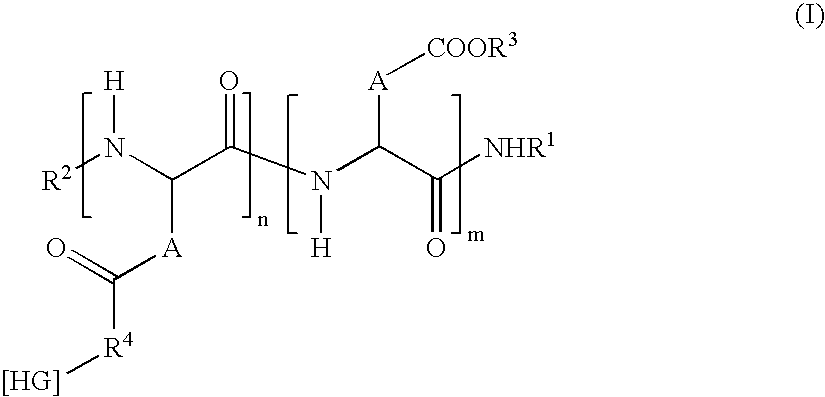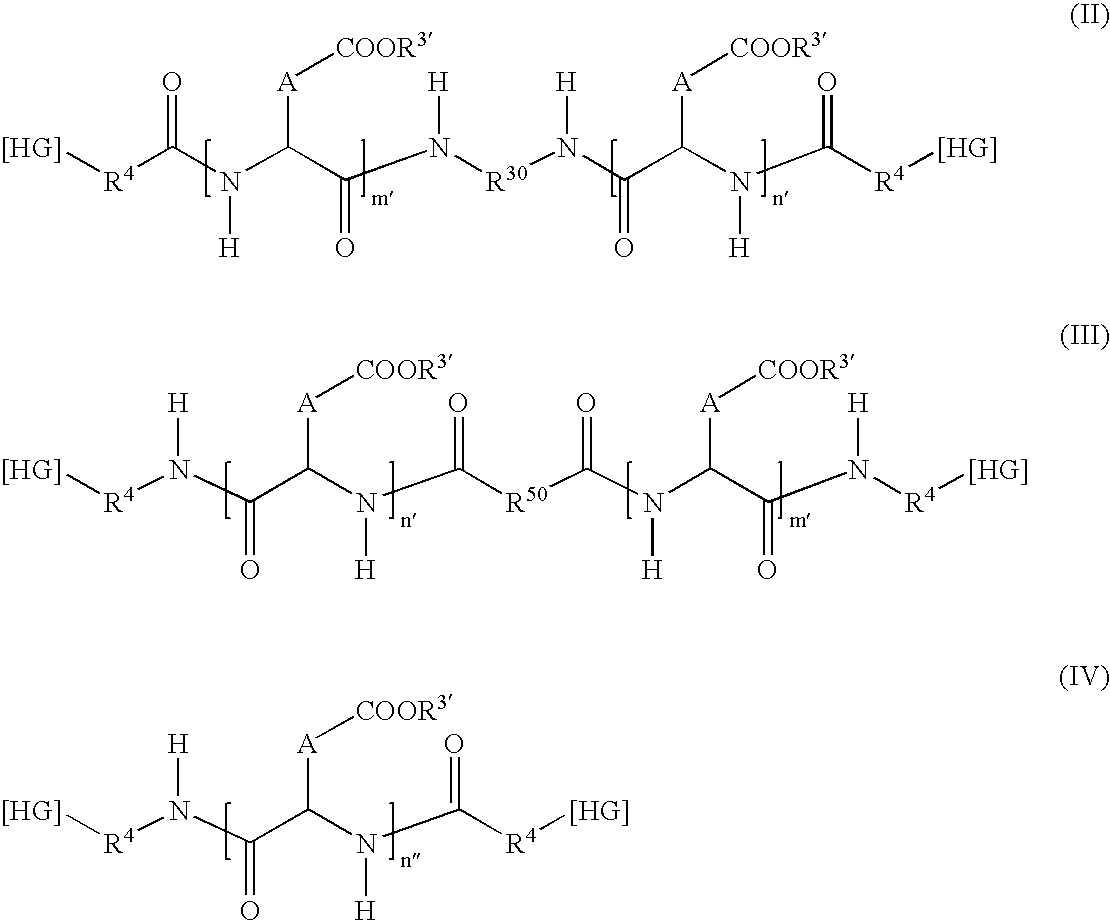Modified-release microparticles based on amphiphilic copolymer and on active principles(s) and pharmaceutical formulations comprising them
a technology of amphiphilic copolymer and active principle, which is applied in the direction of macromolecular non-active ingredients, powder delivery, granular delivery, etc., can solve the problems of limited release duration, poor treatment coverage of patients, serious long-term consequences, and marked harmful effects, so as to reduce the phenomenon of aggregation, easy to obtain liquid formulations, and stable on storage
- Summary
- Abstract
- Description
- Claims
- Application Information
AI Technical Summary
Benefits of technology
Problems solved by technology
Method used
Image
Examples
example 1
Synthesis of an Amphiphilic Polymer PO-A
Synthesis of a Polyglutamate Grafted by α-Tocopherol of Synthetic Origin
[0396] 15 g of a poly(α-L-glutamic acid) (with a weight equivalent to approximately 16 900 Da with respect to a polyoxyethylene standard and obtained by polymerization of NCAGluOMe, followed by hydrolysis, as are disclosed in application FR-A-2 801 226) are dissolved in 288 ml of dimethylformamide (DMF) by heating at 80° C. until the polymer has dissolved. The solution is cooled to 15° C. and 2.5 g of D,L-α-tocopherol (>98%, obtained from Fluka®), dissolved beforehand in 8 ml of DMF, 280 mg of 4-dimethylaminopyridine, dissolved beforehand in 1 ml of DMF, and 1.6 g of diisopropylcarbodiimide, dissolved beforehand in 6 ml of DMF, are successively added. After stirring for 3 h, the reaction medium is poured into 1200 ml of water comprising 15% of sodium chloride and hydrochloric acid (pH=2). The precipitated polymer is subsequently recovered by filtration and washed with 0....
example 2
Synthesis of an Amphiphilic Polymer PO-B
[0397] Example 2 is adapted from example 1, a degree of grafting of 20% being targeted.
example 3
Preparation of Dry Micron-Scale Particles of Polymer PO-A Comprising IFN-α2B
Preparation of a Solution Comprising 20 mg / g of Polymer and 0.25 mg / g of IFN
[0398] 200 g of 30 mg / g solution of polymer PO-A are introduced into a 500 ml flask. 68 g of water are subsequently introduced into the flask comprising the polymer. A frozen solution of IFN-α-2b concentrated to 2.8 mg / g is defrosted at 25° C. for 1 h and 26.8 g of this defrosted solution are introduced into the flask comprising the polymer solution. The mixture is left at ambient temperature for 14 h.
[0399] The solution is filtered through a 0.2 μm sterilizing filter.
Atomization of the Polymer-IFN Solution
[0400] The solution is atomized on a spray-drying device of Büchi B290 type. The liquid solution is sucked up at a rate of 5 ml / min and nebulized through a spray nozzle fed with nitrogen (700 kPa, 900 l / h). The suction flow rate (drying air) is 40 m3 / h. The inlet temperature is maintained at 90° C., which results, under thes...
PUM
| Property | Measurement | Unit |
|---|---|---|
| pH | aaaaa | aaaaa |
| size | aaaaa | aaaaa |
| size | aaaaa | aaaaa |
Abstract
Description
Claims
Application Information
 Login to View More
Login to View More - R&D
- Intellectual Property
- Life Sciences
- Materials
- Tech Scout
- Unparalleled Data Quality
- Higher Quality Content
- 60% Fewer Hallucinations
Browse by: Latest US Patents, China's latest patents, Technical Efficacy Thesaurus, Application Domain, Technology Topic, Popular Technical Reports.
© 2025 PatSnap. All rights reserved.Legal|Privacy policy|Modern Slavery Act Transparency Statement|Sitemap|About US| Contact US: help@patsnap.com



